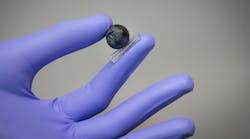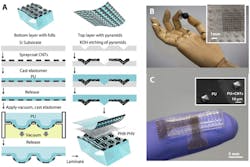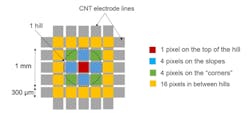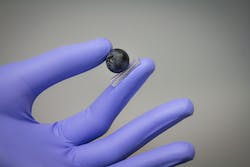Electronic Skin Emulates Hand’s Sensing of Pressure, Shear Force
The multifaceted challenges of developing a robotic hand that closely emulates the human original continue to be the subject of considerable research. No doubt, progress has been made in duplicating some of its many functions and features across one or a few performance aspects, such as grasping and manipulation. However, the human hand combines so much: bone structure; muscle power; fully controlled articulation; pressure, shear, motion, acceleration, temperature sensing; and more—and it can use these attributes over a wide dynamic range.
Work being done at Stanford University shows both the challenges and the progress made in trying to provide the same sensing ability of human skin. The objective of the glove developed by the team led by chemical engineer Zhenan Bao is to embed “continuous” sensors in the glove’s fingertips. The sensors would simultaneously measure the intensity and direction of pressure—two feedback factors critical to achieving fully controlled dexterity, a feat which the human hand provides without conscious thought.
Before looking at this glove, it’s worth looking at the structure of skin, which is much more than a flexible, nerve-laden enclosure. The outer skin layer is permeated with sensors to detect pressure, heat, and other stimuli; of course, the fingers and palms are dense with touch sensors. But that’s only the top layer of the story, so to speak. Beneath the top layer is a sublayer of skin called the spinosum, which looks like a bumpy microscopic terrain of hills and valleys. Those bumps are an essential part of the sensing “mechanism.”
The two skin layers work closely together to integrate sensory signals. When a finger touches a surface, the outer layer of skin moves closer to the underlayer spinosum. Light touches are felt primarily by the hilltops of the spinosum, while heavier pressure pushes the outer skin down into spinosum’s valleys to initiate a more-intense touch sensation.
While this may seem fairly straightforward, it’s only a part of the story. The skin’s bumpy-layer sensing does more: it reveals the direction (shear force) of the pressure. As a finger presses in one direction, strong sensing signals are created on the opposite side of the microscopic hills. The ability to sense and assess the magnitude of this shear force is critical to achieving gentle but firm actions such as holding a fragile object between the thumb and forefinger.
The engineering challenge is to create a multilayer glove that can electrically replicate these skin functions. To do this, the team used a three-layer arrangement, with electrically active top and bottom layers separated by an insulating rubber layer. The bottom layer also has small bumps—pyramids—similar to skin; together they form a two-dimensional grid with a dense array of sensing points. This arrangement of nanocapacitors is comprised of carbon-nanotube (CNT) top and bottom electrodes embedded into a polyurethane (PU); they can measure and discriminate between normal forces (perpendicular to the surface) and tangential (shear) forces (Fig. 1).
1. E-skin fabrication and assembly (A)—the device consists of three layers, assembled by lamination: a bottom 1-mm-thick PU layer with an array of hills (hill diameter, 1 mm; height, 200 μm) (i); an intermediate 10-μm-thick dielectric layer used as a spacer between the top and bottom electrodes (ii), and a top 60-μm-thick PU layer with an array of pyramids (iii). The electrodes were made of spray-coated and photolithography-patterned conducting CNTs embedded into the PU matrix (electrode width, 300 μm; separation distance between two electrodes, 50 μm). Optical image of a fabricated e-skin and close-up view on the hills and electrodes (inset) (B). Optical image showing the CNT-PU interconnects for signal recording with LCR meter and SEM picture of the top e-skin layer with molded pyramids, showing CNT-PU and PU areas (inset) (C).
But these sensing points aren’t simple capacitors. The top layer of the e-skin comprised a grid of molded square pyramids that elastically deform when an external pressure is applied. The bottom layer of the e-skin uses a two-dimensional array of molded hills to mimic the spinosum layer in human skin; these are essential for measuring and discriminating the direction of the applied force. Each hill corresponds to 25 capacitors, each 90,000 μm2 in size, with one capacitor at the top of the hill, four on the slopes, four on the corners, and 16 surrounding the hill (Fig. 2).
2. Schematic of the position of the different capacitors (pixels) around a hill, with one on the top of the hill, four on the slopes, four on the corners, and 16 between hills.
The capacitors located on the side of the hill and exposed to a greater pressure had a larger increase in capacitance than those located on the side opposite the applied force direction (normal force, shear, and tilt force, respectively) (Fig. 3). The capacitance map around a hill provided the ability to differentiate several types of applied forces, while an individual pixel alone isn’t able to provide this information.
3. Measured response characteristics of the biomimetic e-skin; the sensor array of 5 × 5 capacitors, centered on one hill, is characterized by measuring the pressure response curve upon applied normal force (a), applied shear force (b), and applied tilt force (c). Each color band corresponds to a variation ΔC/Cmin of 5%, corresponding to the capacitances without and with applied pressure.
Note that the team investigated the e-skin parameters via simulation to maximize the sensitivity, the SNR, and the time-response tradeoffs. They used various pyramid sizes (widths of 10, 20, 30, 40, and 50 μm) and separation distances (ratio b/a = 0.4, 0.8, 1.2, 1.6, 2, and 4, where a + b is the distance between the centers of two pyramids).
The glove was placed over a mock-up flexible hand attached to a Schunk WSG 50 gripper mounted on a KUKA IIWA robot arm to provide actuation. Algorithms used the sensed readings in a feedback loop to direct the glove-wearing robotic hand to gently touch a berry or lift and move a ping-pong ball as a human hand would do. This was accomplished using the sensors to indicate the shear force as well as control the gloved hand to modulate its actions as needed for human-like functions (Fig. 4).
4. The sensor arrangement is sensitive enough to allow the finger to pick up and hold a blueberry without crushing it.
Full details of human-skin fundamentals as well as e-skin design, materials, fabrication, and application are in a very readable and informative paper published in Science Robotics, “A hierarchically patterned, bioinspired e-skin able to detect the direction of applied pressure for robotics,”along with its “Supplementary Information.”
This work was supported in part by the Swiss National Science Foundation, the European Commission, the National Science Foundation, and the Stanford Nano Shared Facilities.





